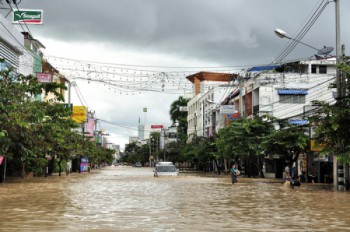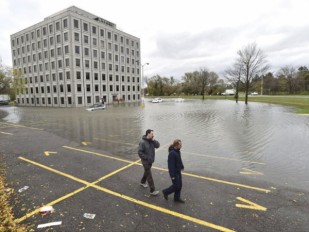The 'urban heat island' effect could force several major cities to face climate change costs at least twice as big as the rest of the world

Some of the world’s largest cities could face temperatures up to 8°C higher than those of today, because of the combination of increased greenhouse gas emissions and the ‘urban heat island’ effect, as cement and asphalt amplify the impact of climate change.
Some of the world’s largest cities could face temperatures up to 8°C higher than those of today, because of the combination of increased greenhouse gas emissions and the ‘urban heat island’ effect, as cement and asphalt amplify the impact of climate change.
This is the worrying estimation of a new study conducted by an international team of economists and it is the first to quantify the potentially devastating combined impact of global and local climate change on urban economies. The study, led by Prof. Francisco Estrada from the Institute for Environmental Studies (IVM) in Amsterdam, analyzed data for the world’s 1,692 largest cities during the period 1950-2015, estimating that the total economic costs of climate change for cities this century could be 2.6 times higher when heat island effects are taken into account than when they are not. Although these cities cover only around 1% of the Earth's surface, they are home to over half of the world's population, they produce about 80% of Gross World Product and consume about 78% of the world's energy, while producing over 60% of total greenhouse gases emissions. These estimations are based on the ‘worst-case’ scenario that greenhouse gas emissions will continue to rise during the 21st century. If this is the case, then 1 out of 4 most populated cities globally may face temperatures increased by 7°C till 2100, while the temperature may rise even by 8°C in 5% of the cities. As far as the economy is concerned, for the worst-off city losses could reach 10.9% of GDP by the end of the century, compared with a global average of 5.6%, as higher temperatures damage the economy in various ways (more energy consumed for cooling, heavier air pollution, worse water quality and many more). The analysis was published in the journal Nature Climate Change.
The ‘heat island’ effect
The urban heat island occurs when natural surfaces (such as parks and lakes) that constitute a cool oasis, are replaced by heat-trapping concrete and asphalt. The situation is further exacerbated by heat from cars, air conditioners etc. The authors believe that their new research will show the high importance of local interventions in the battle against global climate change. "Any hard-won victories over climate change on a global scale could be wiped out by the effects of uncontrolled urban heat islands. We show that city-level adaptation strategies to limit local warming have important economic net benefits for almost all cities around the world", says Professor Richard S.J. Tol MAE, Professor of Economics at the University of Sussex.
Measures to be taken
In order to limit the high economic and health costs of rising urban temperatures, it seems that the adoption of measures is imperative for policy makers (to combat the urban heat island effect). According to a cost-benefit analysis held by the research team, between enhancements such as cool pavements, cool and green roofs and expanding vegetation in cities, the cheapest one is a moderate-scale installation of cool pavements and roofs. Changing 20% of a city's roofs to ‘green’ ones and 50% of its pavements to ‘cool’ ones could save up to 12 times what they cost to install and maintain, and reduce air temperatures by about 0.8 degrees. The larger the scale, the bigger the benefits, although the cost-benefit ratio would be smaller. "It is clear that we have until now underestimated the dramatic impact that local policies could make in reducing urban warming. However, this doesn't have to be an either/or scenario. In fact, the largest benefits for reducing the impacts of climate change are attained when both global and local measures are implemented together. And even when global efforts fail, we show that local policies can still have a positive impact, making them at least a useful insurance for bad climate outcomes on the international stage.", says Professor Tol.
Source: Science Daily
Source: Science Daily
Want to read more like this story?

Cities to live in to escape climate change
Nov, 11, 2016 | NewsA list of the most climate change-adaptive cities in North America A list of the most climate cha...

How to reduce temperature in urban environments
Jul, 29, 2019 | NewsA new study conducted by the Portland State examines how vegetation and reflective materials can low...

European cities and climate change: Their adaptation is a necessity in order to survive
Jul, 18, 2016 | NewsA new report from the European Environment Agency (EEA) shows the benefits of investing in long-term...

Satellites can help detect geothermal energy under our cities
Feb, 29, 2016 | NewsLinking Surface Urban Heat Islands with Groundwater Temperatures Linking Surface Urban Heat Islan...

Climate change brings new challenges in road surfaces
Jul, 24, 2019 | NewsAccording to a new study, the thickness of asphalt layers should increase by 7% to 32% in order...

The Earth Is Still Too Hot!
Jun, 08, 2015 | NewsDespite the widespread impression that in recent years there has been some respite and slowdown in c...

The majority of world population could face deadly heat waves by 2100
May, 25, 2018 | NewsUp to 75% of people could be exposed to extreme heat conditions Up to 75% of people could be expo...

Canada changes its building code to tackle climate change
Apr, 15, 2019 | NewsCanada's building code is heading towards environmental sustainability. The new regulations will be...

How climate change has affected real estate business
Nov, 11, 2019 | NewsClimate change is a phenomenon that leads to sea water-level rise affecting the coastal areas. But h...
Trending

Vertical gardens in Mexico City to combat pollution

Characteristics of Load Bearing Masonry Construction

Taipei 101’s impressive tuned mass damper

Saudi Park Closed After 360 Big Pendulum Ride Crashes to Ground, 23 injured

Dutch greenhouses have revolutionized modern farming

Federal court rules Biden’s offshore drilling ban unlawful


